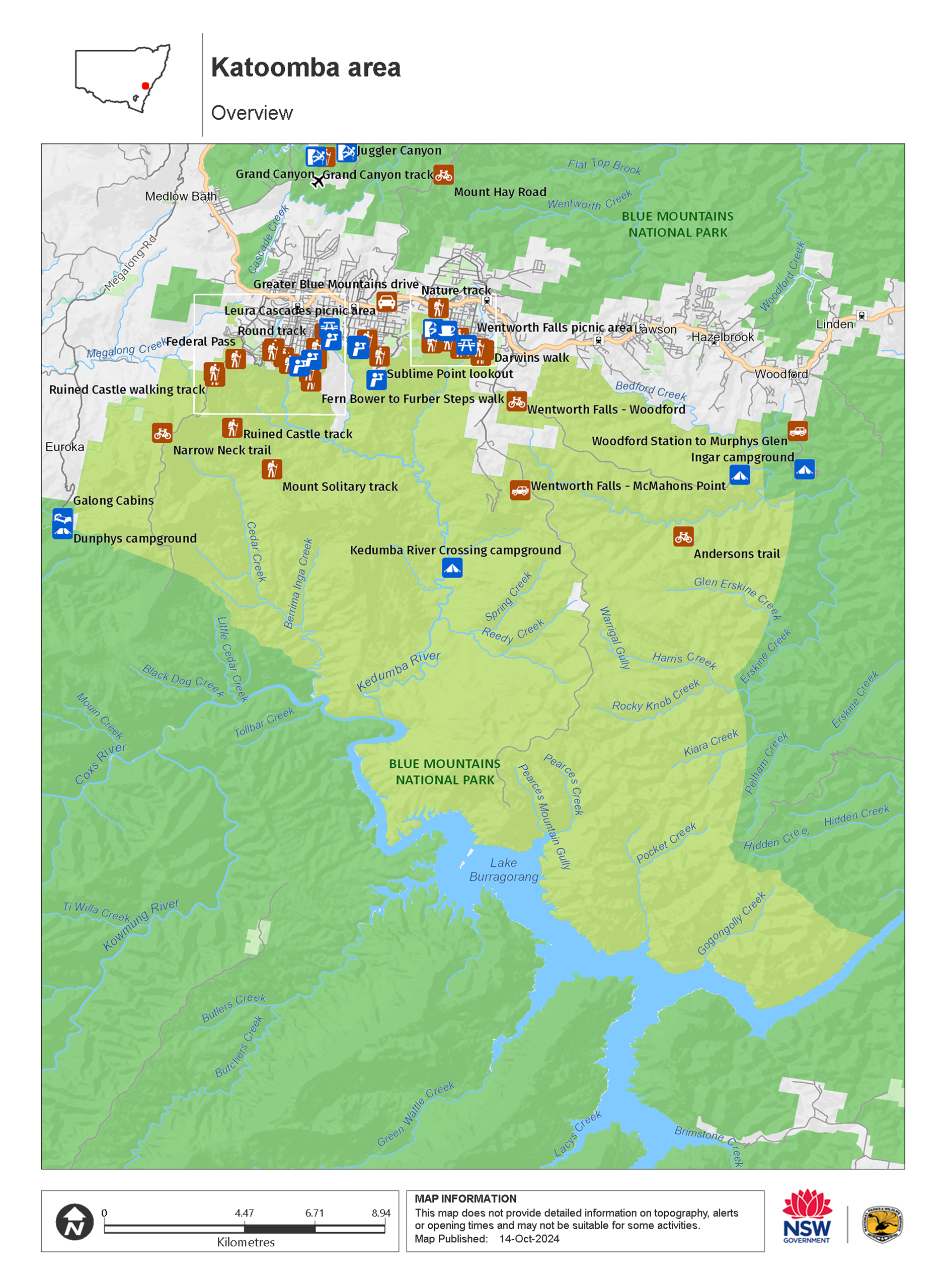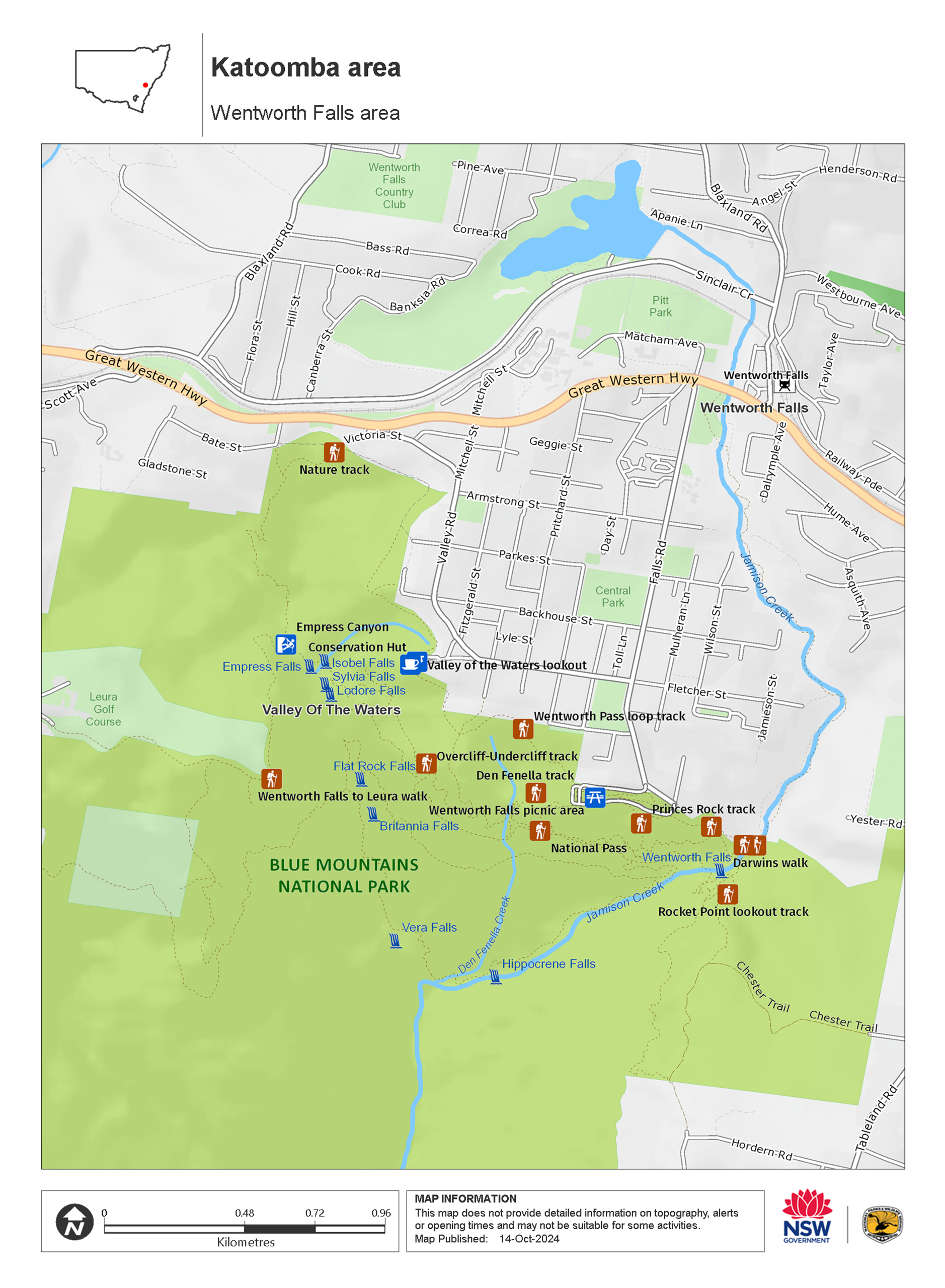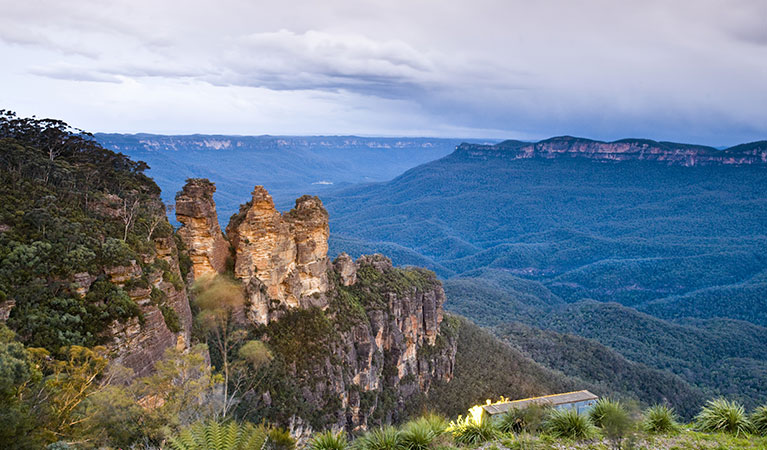Katoomba area
Blue Mountains National Park
Overview
Katoomba area is the heart of Blue Mountains National Park. This popular day trip from Sydney is home of the iconic Three Sisters as well as Grand Cliff Top Walk. It's packed with world-class views and waterfalls, including Wentworth Falls.
Read more about Katoomba area
The dazzling natural beauty of the Wentworth Falls, Leura, and Katoomba areas has drawn visitors to Gundungurra County for over 100 years. Why not immerse yourself in the best of the Blue Mountains and hike 19km over 2 days between these villages on Grand Cliff Top Walk?
Echo Point is a Blue Mountains favourite where you can marvel at famous views of the Three Sisters rock formation, Mount Solitary, and the dramatic sandstone cliffs towering above the Jamison Valley.
From family-friendly strolls to challenging descents into World Heritage-listed wilderness, Katoomba area is a walker’s paradise. Take in ever changing views along Prince Henry Cliff walk which boasts over 20 lookouts and 3 waterfalls between Katoomba and Leura. Swap cliff top for cool rainforest on Round walking track which is easily combined with a Scenic World ride. The historic Giant Stairway will test your legs as it zig zags down the cliff face to meet the heart-pumping Federal Pass.
Short on time? Head to Wentworth Falls. You won’t have to stroll far from the picnic area to find a panoramic lookout or scenic walk to a cascading waterfall. Wentworth Falls track and historic Princes Rock lookout are highlights. Enjoy a relaxing picnic serenaded by birdsong or grab a meal at Conservation Hut. Then walk it off via the rock overhangs and summer wildflowers of Overcliff-Undercliff track. The Valley of the Waters offers a shady retreat with facilities on a hot summer day.
Thrill seekers can take to 2 wheels along the exhilarating Narrow Neck peninsula, also a popular spot for abseiling and rock climbing tours. The fire trails of Kings Tableland offer remote mountain biking and camping adventures, while intrepid hikers will want to tackle the fabled Six Foot track.
Local alerts
For the latest updates on fires, closures and other alerts in this area, see https://uat.nswparks.cloud/visit-a-park/parks/katoomba-area/local-alerts
Map

Map

Map

Map legend

Contact
- in Blue Mountains National Park in the Sydney and surrounds region
Katoomba area is always open but some locations may close at times due to maintenance, poor weather or fire danger.
-
-
Blue Mountains Heritage Centre and Blackheath office
02 4787 8877
Contact hours: 9am to 4.30pm daily. Closed Christmas Day. - 270 Govetts Leap Road, Blackheath NSW 2785
-
Email: bluemountains.heritagecentre@environment.nsw.gov.au
-
Blue Mountains Heritage Centre and Blackheath office
Visitor info
All the practical information you need to know about the Katoomba area.
Maps and downloads
Nearby towns
Wentworth Falls (2 km)
Wentworth Falls is a historic town in the Blue Mountains. It's a good base to explore this World Heritage-listed area on foot.
Katoomba (3 km)
Katoomba is at the heart of most of the stunning natural attractions that make up the Blue Mountains National Park. You can admire deep valleys, sandstone plateaus, waterfalls and native animals from the many walking trails and lookouts near Katoomba.
Sydney City Centre (105 km)
No trip to Sydney is complete without spending some time in the city’s beautiful parks. Whether it’s in central areas like Hyde Park or the Royal Botanic Gardens or further out in Centennial Parklands, there’s plenty of green space to go out and enjoy.
Learn more
Katoomba area is a special place. Here are just some of the reasons why:
Plants and animals protected in this park
Animals
-

Superb lyrebird (Menura novaehollandiae)
With a complex mimicking call and an elaborate courtship dance to match, the superb lyrebird is one of the most spectacular Australian animals. A bird watching must-see, the superb lyrebird can be found in rainforests and wet woodlands across eastern NSW and Victoria.
-

Wedge-tailed eagle (Aquila audax)
With a wingspan of up to 2.5m, the wedge-tailed eagle is Australia’s largest bird of prey. These Australian animals are found in woodlands across NSW, and have the ability to soar to heights of over 2km. If you’re bird watching, look out for the distinctive diamond-shaped tail of the eagle.
-

Yellow-tailed black cockatoo (Calyptorhynchus funereus)
The yellow-tailed black cockatoo is one of the largest species of parrot. With dusty-black plumage, they have a yellow tail and cheek patch. They’re easily spotted while bird watching, as they feed on seeds in native forests and pine plantations.
-

Eastern water dragon (Intellagama lesueurii lesueurii)
The eastern water dragon is a subaquatic lizard found in healthy waterways along eastern NSW, from Nowra to halfway up the Cape York Pensinsula. It’s believed to be one of the oldest of Australian reptiles, remaining virtually unchanged for over 20 million years.
-

Kookaburra (Dacelo novaeguineae)
Of the 2 species of kookaburra found in Australia, the laughing kookaburra is the best-known and the largest of the native kingfishers. With its distinctive riotous call, the laughing kookaburra is commonly heard in open woodlands and forests throughout NSW national parks, making these ideal spots for bird watching.
-

Short-beaked echidna (Tachyglossus aculeatus)
One of only 2 egg-laying mammals in the world, the short-beaked echidna is one of the most widespread of Australian native animals. Covered in spines, or quills, they’re equipped with a keen sense of smell and a tube-like snout which they use to break apart termite mounds in search of ants.
Plants
-

Old man banksia (Banksia serrata)
Hardy Australian native plants, old man banksias can be found along the coast, and in the dry sclerophyll forests and sandstone mountain ranges of NSW. With roughened bark and gnarled limbs, they produce a distinctive cylindrical yellow-green banksia flower which blossoms from summer to early autumn.
-

Grass tree (Xanthorrea spp.)
An iconic part of the Australian landscape, the grass tree is widespread across eastern NSW. These Australian native plants have a thick fire-blackened trunk and long spiked leaves. They are found in heath and open forests across eastern NSW. The grass tree grows 1-5m in height and produces striking white-flowered spikes which grow up to 1m long.
-

Scribbly gum (Eucalyptus haemastoma)
Easily identifiable Australian native plants, scribbly gum trees are found throughout NSW coastal plains and hills in the Sydney region. The most distinctive features of this eucalypt are the ‘scribbles’ made by moth larva as it tunnels between the layers of bark.
-

Smooth-barked apple (Angophora costata)
Smooth-barked apple gums, also known as Sydney red gum or rusty gum trees, are Australian native plants found along the NSW coast, and in the Sydney basin and parts of Queensland. Growing to heights of 15-30m, the russet-coloured angophoras shed their bark in spring to reveal spectacular new salmon-coloured bark.
-

Waratah (Telopea speciosissima)
The beautiful waratah is not only the NSW floral emblem, it's also one of the best-known Australian native plants. This iconic Australian bush flower can be found on sandstone ridges around Sydney, in nearby mountain ranges and on the NSW South Coast. The waratah has a vibrant crimson flowerhead, measuring up to 15cm across, and blossoms in spring.
Environments in this area
School excursions (5)
- Explore a national park, Stage 2 (Years 3-4), Geography
- Living Country, living culture, Stage 2 (Years 3-4), History
- Mountain landscapes: Blue Mountains, Stage 4 (Years 7-8), Geography
- Rainforests and waterfalls, Stage 3 (Years 5-6), Geography
- Living Country, living culture, Stage 1 (Years 1-2), Geography
What we're doing
Katoomba area has management strategies in place to protect and conserve the values of this park. View the detailed park and fire management documents. Here is just some of the work we’re doing to conserve these values:

